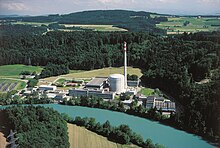Mühleberg Nuclear Power Plant
| Mühleberg Nuclear Power Plant | |
|---|---|

Mühleberg Nuclear Power Plant
|
|
| Country | Switzerland |
| Location | Mühleberg (BE) |
| Coordinates | 46°58′8″N 7°16′5″E / 46.96889°N 7.26806°ECoordinates: 46°58′8″N 7°16′5″E / 46.96889°N 7.26806°E |
| Status | Operational |
| Construction began | 1967 – 1971 |
| Commission date | 6 November 1972 |
| Operator(s) | BKW FMB Energie AG |
| Nuclear power station | |
| Reactor type | BWR |
| Reactor supplier | General Electric |
| Power generation | |
| Units operational | 1 × 355 MW |
| Make and model | 2 (Brown Boveri) |
| Nameplate capacity | 355 MW |
| Capacity factor | 95.6% |
| Average generation | 2,973 GW·h |
|
Website Official website |
|
The Mühleberg Nuclear Power Plant (German: Kernkraftwerk Mühleberg, KKM) is located in the Mühleberg municipality in the (Canton of Berne, Switzerland) north of the village of Mühleberg and near a hydroelectric plant. It is operated by the BKW FMB Energie AG.
In parallel with the planning of Beznau 1, the then Bernische Kraftwerke AG decided to build a second nuclear power plant in the canton of Berne. Mühleberg was identified as possible location and the Swiss Federal Office of Energy (SFOE) approved this choice on 21 July 1965. Two years later, on 21 March 1967, a first partial construction permit was issued, followed on 7 March 1968 by the final one.
The reactor entered criticality in March 1971 but, due to a fire in a turbine housing, the plant had to be shut down for repairs. It eventually started commercial operation on 6 November 1972.
KKM was the only Swiss nuclear power plant that did not have an unlimited operating license. Due to the problems noticed during the commissioning and to some ongoing tests on the emergency cooling systems performed in the United States, until 1980 it received a series of six-month license extensions, then increased to one year. They were followed by a five-year, a seven-year, and a 10-year license extension. These extensions were justified by technical improvements the operator was instructed to perform. The operating license was extended again in 1998 and was due to expire on 31 December 2012; however, an unlimited license was granted on December 21, 2009.
The plant had requested a limitation removal in 1990 and again in 1996, but they were both rejected by the Swiss Federal Council for political and technical reasons. A third request pending since 2005 at the SFOE was accepted on December 21, 2009.
Acceptance of the power plant by the local population has varied. When KKM was built there was little opposition to nuclear energy, but the situation rapidly changed after the Chernobyl disaster. In 1992 a public referendum in the canton of Berne rejected granting an unlimited operating license to the power plant, with 51% voting against. In 2003, 68% of the population rejected the initiative named Strom ohne Atom, that proposed that the plant should be shut down in 2005 to be replaced by non-nuclear power generation. A similar proposal at cantonal level had already been rejected in 2000 by 64% of voters. In 2006 the Bernese government put forward a medium-term energy strategy including the renunciation to nuclear power. The Swiss parliament, however, noted this and withheld its approval, delegating any decision on an eventual shutdown to the federal authorities. The same organ in 2007 urged the Bernese government to work towards granting an unlimited operating license.
...
Wikipedia

